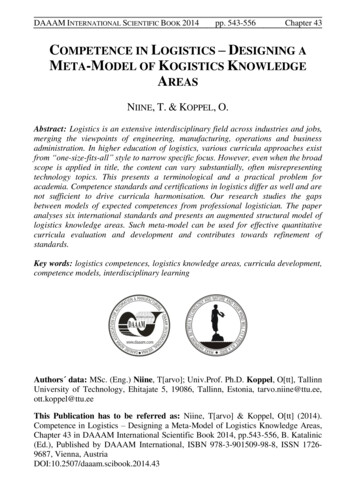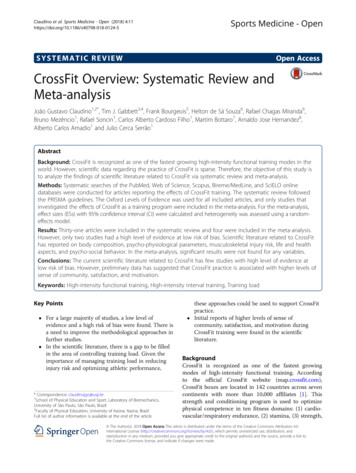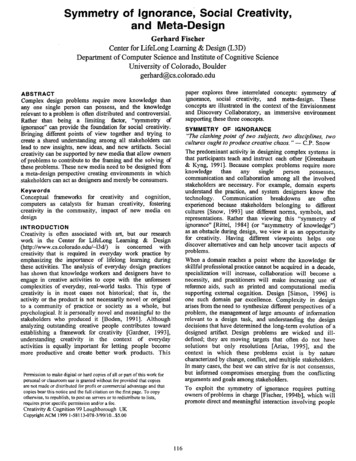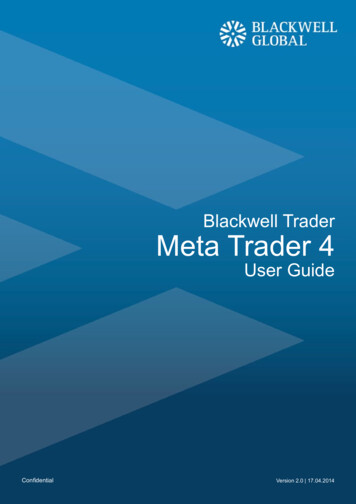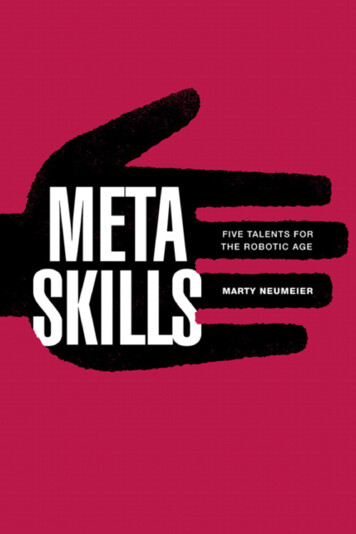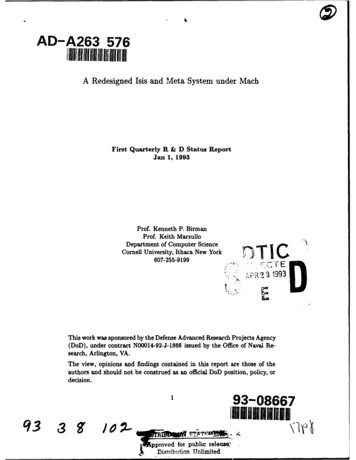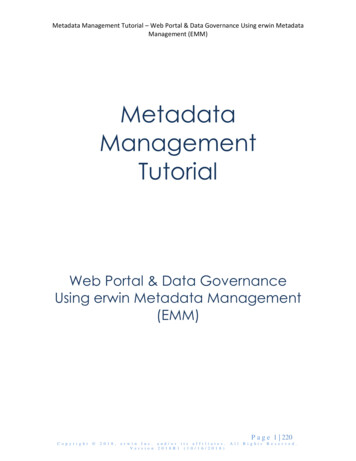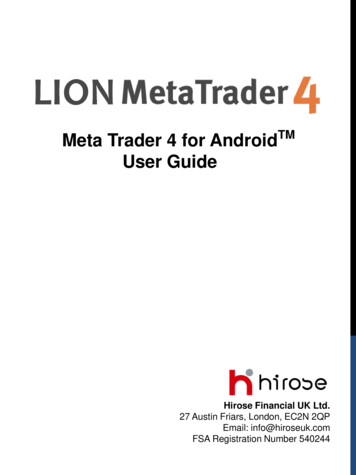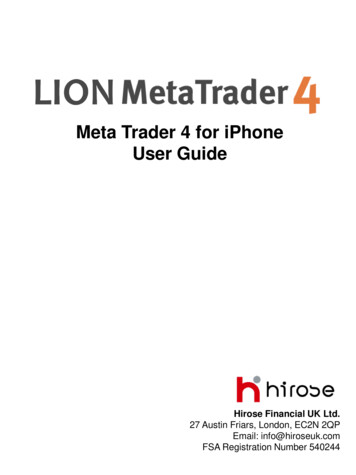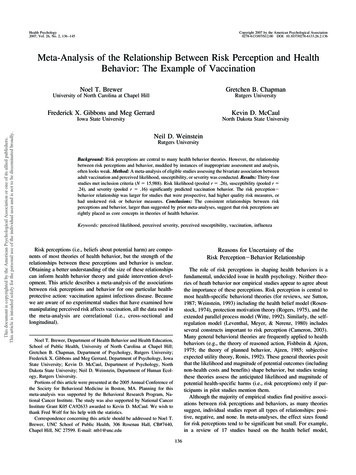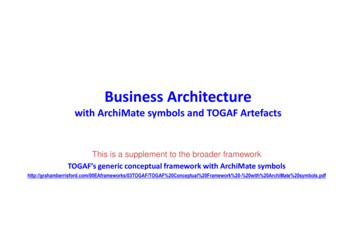
Transcription
Business Architecturewith ArchiMate symbols and TOGAF ArtefactsThis is a supplement to the broader frameworkTOGAF’s generic conceptual framework with ArchiMate 20ArchiMate%20symbols.pdf
Business architecture premisesCopyright Avancier Limited March 2016 http://avancier.website page 2 of 13 EA is about the design, improvement and optimisation of information-intensive business systems. TOGAF and ArchiMate presume a business is required to perform discrete behaviors that:– produce results of value (if only to keep records up to date)– are often called services, scenarios or value streams– are triggered by discrete events, and run over time– are performed by actors or components (structures that occupy space and must be addressable)– create and use business data objects (data entities and events that contain a data structure oritem that is meaningful or valuable to its creators and users). None of these points imply or require the existence of computers; they are just about how businesssystems are modelled.But obviously, the creation and use of information is an important facet of business architecture. Copyright Avancier Limited March 2016 http://avancier.website
A business architect role: exampleCopyright Avancier Limited March 2016 http://avancier.website page 3 of 13ResponsibilitiesQualifications Engage and build relationships with customer stakeholders to define,extract, and capture clear understanding of business needs and prioritiesFacilitate and resolve competing stakeholder priorities by preparing andconducting meetings defining the opportunities and threats tooverlapping requirements.Demonstrate extensive knowledge of business process modeling,enterprise business architecture, and visualization of business needsand the multiple faces of software architectureDevelop an understanding of client needs and routinely interact withinternal and external customersAnalyze, visualize, and capture business processes, scenarios, usecases, and acceptance criteria and other artifacts for business andtechnical requirementsConvert functional requirements into testable requirements and processflowsWork with stakeholders to achieve a common business flow and resultingcapability.Prepare presentations that accurately detail the requirements,assumptions and potential risks of implementing new or enhancedfunctionalityGet to know the team, customer, and applicationsLeading elaboration on business products and features.Contribute to Scrum teams as a lead business proxy. You will alsounderstand the intricacies of the product to be able to facilitatediscussions with customers on business value and priority.Become go-to-lead for business architecture discussions across theprogram and drive initiatives to define the product roadmap and vision. Exceptional communication and facilitation skills and the ability to communicateappropriately at all levels of the organization.Ability to manage tasks to deadlinesStrong situational analysis and decision making.Proven experience working with stakeholders that have inconsistent, diverserequirements and goals and bring the group to a rational decisionThe ability to act as liaison conveying information needs of the business to IT anddata constraints to the business; applies equal conveyance regarding businessstrategy and IT strategy, business processes and work flow automation, businessinitiatives and IT initiatives, benefit realization and service deliveryA broad, enterprise-wide view of the business, strategy, processes andcapabilities, enabling technologies, and governance .The ability to recognize structural issues within the organization,functional interdependencies and cross-silo redundanciesThe ability to apply architectural principles to business solutionsThe ability to assimilate and correlate disconnected documentationand drawings, and articulate their collective relevance to theorganization and to high-priority business issuesThe ability to visualize and create high-level models that can be used infuture analysis to extend and mature the business architectureExperience using model-based representations that can be adjusted asrequired to collect, aggregate or disaggregate complex and conflictinginformation about the businessExperience with decomposing business functionality and defining userstories .A willingness to learn, explore new techniques, adopt best practices, and innovateto address customer needsCopyright Avancier Limited March 2016 http://avancier.website
Business architecture practicesCopyright Avancier Limited March 2016 http://avancier.website page 4 of 13 The general idea has always been treat a business organization as a system1. Identify business customers and suppliers2. Identify business inputs, outputs, services (material and/or information flows)3. Decompose a business into subsystems, each with its own inputs and outputs4. Draw the network of subsystems (goods and services flow diagrams)5. Define the end-to-end processes needed to transform inputs into outputs6. Define the resources (roles, equipment, buildings, money etc.) needed to perform processes7. Draw a process flow chart for each core business scenario (with swim-lanes for subsystems, roles,functions or organisation units)8. Measure the time, cost and value of process steps, and inter-step gaps9. Look for inefficiencies in business processes and optimise them. Trouble is – people keep changing the words!Copyright Avancier Limited March 2016 http://avancier.website
TOGAF’s generic conceptual modelCopyright Avancier Limited March 2016 http://avancier.website page 5 of 13Reverse engineer the baseline architectureSMART RequirementsGoal,Objective,RequirementLogical DesignPerformsServiceProcessPhysical ward engineer the target architectureBaseline-to-target gap analysis informs the development of a business change road mapCopyright Avancier Limited March 2016 http://avancier.website
Business architecture terminology variationsCopyright Avancier Limited March 2016 http://avancier.website page 6 of 13Reverse engineer the baseline architectureSMART RequirementsGoal,Objective,RequirementLogical DesignPerformsServiceProcessPhysical ward engineer the target architectureBusiness Architecture terminology edOutcomeScenarioRoleHuman orComputerActorOtherGoods orServiceValue StreamCapabilityOrganisationUnitSome use different terms to differentiate levels of system decomposition. But the Nth level of decomposition differs insystems of different kinds and sizes. So there is no widely-agreed or objective mapping of term to level to concept.Copyright Avancier Limited March 2016 http://avancier.website
TOGAF Business Architecture products & techniquesCopyright Avancier Limited March 2016 http://avancier.website page 7 of 13Principles catalogueDriver/goal/objective catalogueDriverPrinciple!Goal/ oobjectiveRequirementArchitecture Requirements Spec.Business Service/Product catalogueBusinessServiceBusiness architectureFunctional Decomposition (2)Business Function/Service catalogue(1)(2)Processdescribes a business system as anencapsulated Organisation of Actors playingRoles in the performance ofProcesses that maintain system state and realiseServices that produce required outputs from inputs.FunctionOrganisation Decomposition (2)Org/Functionmatrix (2)OrganisationUnitOrganization/Actor catalogueBusiness ScenarioProcess flow diagramRoleActor/RolematrixRole catalogue(1) Services are delivered by the performance of Processes inside the system.Services can be long or short, depending on the scope of the system of interest, and the requirements.(2) “Structured Analysis” defines Functions that group cohesive Process steps,defines longer Processes that coordinate steps in different Functions, and maps Functions to Organisation Units.Copyright Avancier Limited March 2016 http://avancier.websiteActor
Structured Analysis principles (pre dating TOGAF)Copyright Avancier Limited March 2016 http://avancier.website page 8 of 13General principles of hierarchical organisation. We manage atomic system elements (actors, actions and items) by organising them in hierarchical structures. Top-down, a system can be successively decomposed through several levels to atomic system elements. Bottom -up composition clusters atomic elements using cohesion criteria (e.g. data created, skills needed). A strict hierarchy has no duplicate elements; a redundant hierarchy has duplicated elements. A strict hierarchy is best refined by iterative top-down decomposition and bottom-up composition.TOGAF 9.1 Business Architecture artefacts are based on "structured analysis" in which there is/are: A physical business hierarchy - an Organisation Decomposition - units with managers and human Actors. A logical business hierarchy - a Functional Decomposition – independent of the management structure. Several end-to-end business behaviors - Processes – which coordinate atomic Functions.Principle 1: you can cluster cohesive business activities and abilities into logical groups called Functions. You can form a strict hierarchy called a Functional Decomposition (cf. Capability Map). It is possible to build more than one Function hierarchy (a “Function forest"). It is advisable to avoid using the word "management" in the names of Functions.Principle 2: you can place every atomic activity in a Process under one node in a strict Function hierarchy. If you cannot do this, then the Function hierarchy must be redundant or incomplete. (Or, I should add, the process has been decomposed to the level of generic platform activities.)In practice, people usually stop decomposing the Function hierarchy at higher (3rd or 4th) level.And commonly model atomic Process steps at lower (5th or 6th) level.Copyright Avancier Limited March 2016 http://avancier.websiteFunctional DecompositionFunctionOrg/Function matrixOrganisationUnitOrganisation Decomposition
Capabilities as FunctionsCopyright Avancier Limited March 2016 http://avancier.website page 9 of 13 A principle of “structured analysis” is that changes to an Organisation’s management structure can be madewithout requiring changes a more logical Functional Decomposition structure. A Functional Decomposition groups a business’s activities and abilities under logical businesscomponents called Functions (which might be listed rather than arranged in a hierarchy). An Organisation Decomposition groups a business’s activities and abilities under a structure ofOrganisation Units, each with a manager, goals and resources. It might be a “Functional Organisation”structure (that is, similar to the Functional Decomposition) but it can be restructured without changing themore abstract Functional Decomposition. Architects are advised to relate other system elements (e.g. Data Entities and Applications) to Functions ratherthan Organisation Units. Capability-based planning is based on the same independence-of-management-structure principle. So, Capabilities can be named as and identified with Functions, and occupy the same place in a model. You mightthink of it this way. Capability Function target qualities required resources. Capability an aggregate entity (or view) with a named Function as the root entity. Capability/Functions are not generally identifiable with Organisation Units, but can be seen as logical or candidateOrganisation Units, and if you give each a manager, goals and resources, then you create a “FunctionalOrganisation” structure. So, a Capability/Functional Decomposition may be aligned with an Organization Decomposition, at least for awhile. Still, the former remains an abstraction, separate from the Organisation Units that realise it.Copyright Avancier Limited March 2016 http://avancier.websiteFunctional DecompositionCapability/FunctionOrg/Function matrixOrganisationUnitOrganisation Decomposition
Business Architecture with TOGAF artefactsCopyright Avancier Limited March 2016 http://avancier.website page 10 of 13DriverPrincipleDriver/goal/objective catalogueGoal/ oobjective!Principles catalogueRequirementArchitecture Requirements Spec.EventProductProcess/Event/Control/ Product catalogueBusiness Service/Product catalogueBehavior elementBusiness ServiceLogical structure elementBusiness Function/Service catalogueProcess flow diagramProcessBusiness ScenarioCapability/FunctionPhysical structure elementOrganisation/Function matrixOrganisation UnitFunctional DecompositionOrganisation DecompositionRole catalogueOrganization/Actor catalogueRoleActor/Role matrixCopyright Avancier Limited March 2016 http://avancier.websiteActor (human)
Business Architecture: a generic meta modelCopyright Avancier Limited March 2016 http://avancier.website page 11 of 13TOGAF’s generic terminologyTOGAF assigns a Service portfolio to a Logical Component (cf. a Function, or Interface, in ArchiMate).ServicePerformsLogical ComponentRealisesPhysical ComponentBusiness architecture: a generic meta modelTOGAF assigns a Service portfolio to a Function (or Capability).Behavior elementBusiness ServiceLogical componentPerformsCapability/FunctionPhysical componentRealisesOrganisation UnitOrchestratesProcessRoleCopyright Avancier Limited March 2016 http://avancier.websiteActor (human)
DriverPrinciple!Goal/ oobjectiveBusiness Architecture summaryCopyright Avancier Limited March 2016 http://avancier.website page 12 of 13RequirementEventProduct: might be tangible goods ordata/information or a combination thereof.ProductTriggers orresults fromMay create or useBehavior elementService: a stimulusresponse exchange thatencapsulates Process(es).Orchestrates: coordinatesin a logical sequence.Business ServiceRealised byOrchestratesLogical componentPerforms
– create and use business data objects (data entities and events that contain a data structure or item that is meaningful or valuable to its creators and users). None of these points imply or require the existence of computers; they are just about how business systems are modelled. But obviously, the creation and use of information is an important facet of business architecture .
